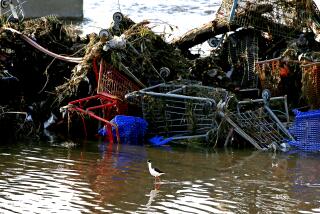Marsh May Be a Cause of ’99 Beach Closure
- Share via
A UC Irvine study of what caused last summer’s high bacteria levels in Huntington Beach remains inconclusive although researchers Friday identified the Talbert Marsh--in combination with ocean tides and urban runoff--as a possible source.
“If you use the ‘smoking gun’ analogy, the urban runoff would be the smoking BB gun and the marsh, the smoking .22, and the smoking cannon is still out there,” said Stanley B. Grant, an engineering professor.
The two-week, $150,000 study conducted in December could not pinpoint what caused mysterious high levels of bacteria that forced two months of closures and economically devastated some Huntington Beach merchants.
The 25-acre wetlands preserve is on the inland side of Pacific Coast Highway at Brookhurst Street. It attracts thousands of migratory birds and other wildlife each year, part of the Talbert watershed which encompasses 12 square miles in Huntington Beach and Fountain Valley. Channels in the marsh have earthen walls that allow absorption while marsh sediment is tainted by wildlife feces.
Ocean water flows into the channels during high tides and then back out, flushing marsh sediment that is carried to the shoreline less than a mile away.
But researchers who spoke at a news conference Friday did not indicate bacteria were directly related to wildlife. They said more study is needed.
“It’s a combination of different sources, but the Talbert Marsh appears to be a significant source of enterococcus [bacteria],” Grant said. “What is the source and how did it get there, we don’t know.”
In addition, researchers warned that until the source is found and dealt with, last summer’s beach closures could happen again.
“Given the data we have . . . I have no reason to believe that history won’t repeat itself,” Grant said.
A task force of local, state and federal agencies conducted an exhaustive, $1.2-million investigation last summer in which they used observers in helicopters and dyes in the outfall pipe, and even floated oranges and grapefruits to determine the bacteria’s source.
In the end, officials were able to rule out only a sewage spill as the cause and began looking at the marsh and urban runoff.
Friday’s UC Irvine study results were disappointing, said Robert P. Ghirelli, manager of technical services for the Orange County Sanitation District, which was part of the task force.
“I think it’s another piece of the puzzle and [Grant] has provided us with additional information. But we now have to look at the birds and wildlife and perhaps the sediment too,” said Ghirelli.
More to Read
Sign up for Essential California
The most important California stories and recommendations in your inbox every morning.
You may occasionally receive promotional content from the Los Angeles Times.













